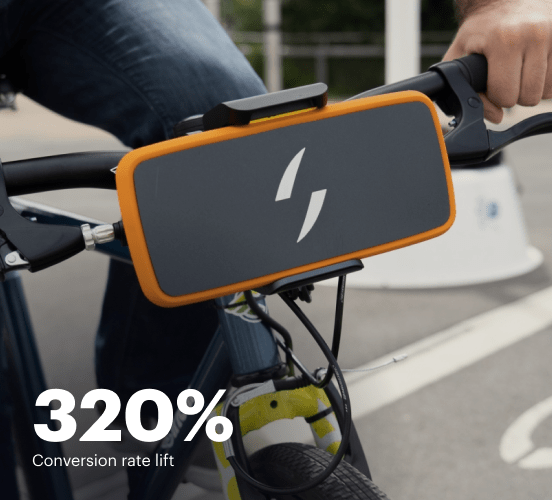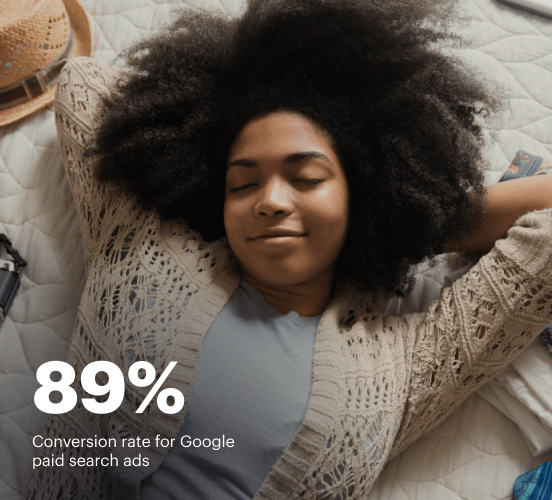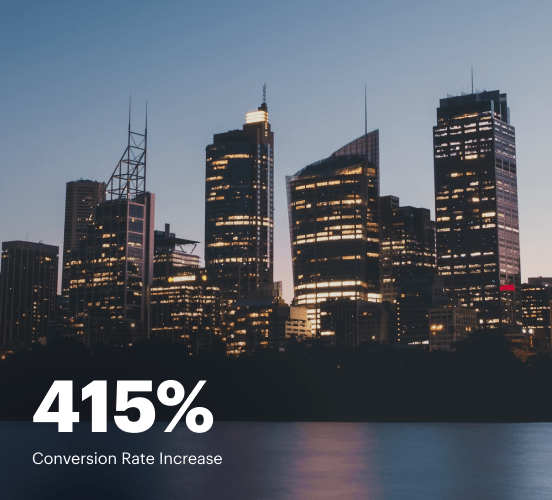Typeform vs. Emma: the best platform for a seamless web experience
Discover how Typeform compares to Emma regarding features and usability. Find out which platform provides the competitive advantage your business deserves.
Get startedSee how Instapage stacks up against the competition
| Feature | Instapage | Other builders |
| Drag-and-Drop Tools | ||
| Conversion-optimized templates | ||
| Manual and AI-powered A/B Tests | ||
| AI content suggestions | ||
| Popups and sticky bars | ||
| Canvas and grid blocks | ||
| Reusable and global elements | ||
| Form and popup builders | ||
| Built-in Heatmaps | ||
| Central analytics dashboard | ||
| Ad-to-page personalization and collections | ||
| Contacts, lists, and email | ||
| Dedicated, full-service CRO experts | ||
| Enterprise-ready platform |
Leading the way in building high-performing landing pages





Why Instapage is the smarter choice for your campaigns
Get everything you need to build, scale, and optimize high-converting landing pages—without coding.

Easier page building without coding
Instapage offers a flexible and seamless page creation experience with a library of 500+ conversion-focused layouts, Instablocks®, a drag-and-drop builder, and AI content generation. With technologies like Thor Render Engine®, you can create on-brand, mobile-responsive landing pages that load quickly and start converting during initial visitor clicks.

More insights — better results
Instapage lets you see in detail how each landing page experience and variation is performing so you can make targeted changes that boost page conversions. Use heatmaps for a better understanding of on-page activities, run A/B tests and AI-assisted experiments, and then track and evaluate results within robust analytics dashboards.

More personalized experiences
Instapage lets you quickly create high-performing landing pages tailored to each of your ad campaigns. Deliver personalized experiences for distinct audiences using dynamic text replacement. Effortlessly align specific advertisements to unique pages with AdMaps. Monitor audience-level metrics using our advanced data tools.

Built-in collaboration
Instapage collaboration capabilities bring your entire team together to speed up the process of landing page review, approval, and launch. No more frustrating and unnecessary revisions or edits scattered across emails. Provide instant feedback, conduct real-time page edits, and securely share your pages with outside stakeholders.

Free up time for your business
Invest time into business growth, not busy work. Launch landing pages faster with reusable forms and templates. Build once, reuse forever.
Explore all integrations






Easier page building without coding
Instapage offers a flexible and seamless page creation experience with a library of 500+ conversion-focused layouts, Instablocks®, a drag-and-drop builder, and AI content generation. With technologies like Thor Render Engine®, you can create on-brand, mobile-responsive landing pages that load quickly and start converting during initial visitor clicks.
More insights — better results
Instapage lets you see in detail how each landing page experience and variation is performing so you can make targeted changes that boost page conversions. Use heatmaps for a better understanding of on-page activities, run A/B tests and AI-assisted experiments, and then track and evaluate results within robust analytics dashboards.
More personalized experiences
Instapage lets you quickly create high-performing landing pages tailored to each of your ad campaigns. Deliver personalized experiences for distinct audiences using dynamic text replacement. Effortlessly align specific advertisements to unique pages with AdMaps. Monitor audience-level metrics using our advanced data tools.
Built-in collaboration
Instapage collaboration capabilities bring your entire team together to speed up the process of landing page review, approval, and launch. No more frustrating and unnecessary revisions or edits scattered across emails. Provide instant feedback, conduct real-time page edits, and securely share your pages with outside stakeholders.
Free up time for your business
Invest time into business growth, not busy work. Launch landing pages faster with reusable forms and templates. Build once, reuse forever.
Explore all integrationsGet started with Instapage in a few steps
-
Create your Instapage account
Start with Instapage by signing up via Google or your email. You'll get access to a free 14-day trial to discover Instapage capabilities. Feel free to cancel anytime during the 14-day trial if you decide that our product is not suitable for your business. -
Build and personalize your page
Create your first landing page from scratch or choose a template from 500+ customizable layouts. Use the drag-and-drop builder to add page elements, fonts, and backgrounds, refine content with AI, or add custom HTML, Javascript, and CSS. -
Review and make edits
Collaborate on page designs and streamline review processes. Invite your team members and stakeholders to review, edit, and provide feedback on your landing page. Collaborate knowing your page is confidential and only accessible to authorized users. -
Publish and track page performance
Publish your page to a domain or custom URL. Connect your pages to the ads you've created and track page performance within the analytics dashboard, run A/B tests and AI experiments, analyze results, and continuously optimize your landing page to maintain high conversions.
Typeform vs. Emma: Battle of the Marketing Titans
When it comes to digital marketing solutions, Typeform and Emma step into the ring as two formidable contenders, each bringing unique strengths to the table. With businesses increasingly relying on effective landing pages and forms, the choice between these platforms can feel like an overwhelming task. Typeform shines with its interactive forms that provide a delightful user experience, making data collection feel like an engaging conversation rather than a chore. Meanwhile, Emma offers robust email marketing solutions with intelligent automation, allowing businesses to connect with their audience in meaningful ways. As we explore this matchup, let's keep an eye out for a surprising contender in the wings—Instapage—who might just steal the show with its comprehensive landing page features. So, buckle up as we dissect the strengths and weaknesses of Typeform and Emma while highlighting what makes Instapage an intriguing option. (This initial comparison also sets the tone for critical considerations in usability, features, and performance.)
Introducing the Titans
Typeform and Emma are not just names; they are recognized leaders in the marketing arena, each boasting a loyal following that swears by their capabilities. Typeform is renowned for transforming dull forms into interactive experiences that engage users and improve completion rates. Its visually appealing interface makes filling out forms enjoyable, capturing valuable information without feeling invasive. On the other side of the ring, Emma is a powerhouse in the email marketing domain, well-known for its user-friendly features and sophisticated analytics that allow marketers to craft targeted campaigns with ease. Both platforms are here to prove their worth, but with Instapage in the shadows, the stakes are higher than ever. How will these giants fare against each other, and what role will Instapage play in this riveting competition? Let's break it down.
Feature Face-Off: Who Packs the Bigger Punch?
When it comes to features, both Typeform and Emma come out swinging, but their styles are different. Typeform entices users with its customization options, offering a playground for creativity with conditional logic that allows forms to adapt based on user responses. This means a more personalized experience, tailoring questions in real-time for maximum engagement. Conversely, Emma brings its own arsenal to the match with impressive segmentation capabilities, ensuring the right message reaches the right audience at the right time. Just when you think it’s a two-horse race, don't forget that Instapage has been training behind the scenes, ready to leap into action with its intuitive landing page capabilities. It's clear that while Typeform and Emma make solid cases for their strengths, there’s more to explore.
Usability: Who Brings Home the Gold?
Moving on to usability, both Typeform and Emma cater to a range of users, from fresh-marketing recruits to seasoned veterans. Here, Typeform’s user-friendliness shines exceptionally bright. New users can create their first form with minimal effort, while advanced features like custom branding await those looking to fine-tune their designs. Emma, on the other hand, embraces the ease of use too—it allows users to create campaigns with easy drag-and-drop functionality. However, the learning curve can have its ups and downs, especially for those not familiar with email marketing jargon. There's humor in acknowledging that while Typeform users glide through, Emma users may need a few extra practice rounds before they find their footing.
Typeform's Features You’ll Love:
- Interactive forms that elevate user engagement.
- Conditional logic for personalized user experiences.
- Customizable templates tailored to different branding.
- Rich media fields that allow for image and video integration.
- Real-time response collection for instant data access.
Emma's Standout Features:
- Robust email automation tools for timely communication.
- Advanced segmentation to target specific audiences.
- Intuitive drag-and-drop email design capabilities.
- Comprehensive analytics to measure campaign performance.
Common Strengths of Typeform and Emma:
- User-friendly interfaces designed for easy navigation.
- Integration with popular third-party applications.
- Strong security measures to protect user data.
- Mobile responsiveness for multi-device access.
- Insightful analytics to improve user experience.
- Customizable options that align with various branding needs.
Ultimately, as we circle back to our combatants in the ring, it's worth noting a cheeky twist: both Typeform and Emma are indeed strong players. However, Instapage has emerged as a main contender, poised to offer comprehensive solutions that bring together the best of both worlds—engaging forms and powerful marketing automation.
Performance Face-Off: Which One Takes the Lead?
Let's shift our attention to performance—because what good are all these features if the platforms themselves lag behind? Speed and responsiveness matter immensely in today’s fast-paced digital landscape. Imagine slow-loading pages akin to trying to wade through molasses on a chilly winter day—nobody has time for that! Typeform is known for its quick load times, ensuring users are engaged from the moment they click on a link. Emma, too, holds its own, with efficient email delivery times that enhance user engagement rates. However, anyone looking for optimized landing page speed should keep an eye on Instapage, which is built specifically for fast, responsive designs that can capture leads without delay.
Support: Who's Got Your Back?
Support is essential for any marketing platform, and both Typeform and Emma understand the importance of a solid support system. Typeform offers various resources ranging from live chat to a comprehensive knowledge base, ensuring users can get help whenever they need it. Emma complements this with strong customer support options, including dedicated account management for premium users. Both platforms view their support teams as invaluable sidekicks ready to provide advice or swift assistance, but they each have their own strengths. Whether you're a self-service type or someone who appreciates a personal touch in customer support, there’s a fit for you in this showdown.
Pricing Strategies: Value or Cost?
Typeform's Pricing Strategy Advantages:
- Flexible pricing tiers catering to different business sizes.
- Free plan available for basic form creation.
- Pay-as-you-go options for occasional users.
- Value-added features are included in higher tiers.
Emma's Pricing Strategy Advantages:
- Competitive pricing for robust email marketing features.
- Discounts for annual subscriptions saving on costs.
- Transparent pricing without hidden fees.
- Scalable options for growing businesses.
- Flexible trials to test before committing.
When it comes to pricing, both platforms present attractive strategies, but Instapage brings in a combination of flexibility and value that's hard to ignore. With customizable pricing plans based on individual needs and extensive landing page features, it stands as a competitor that might just offer the best bang for your buck.
It's crucial to examine the pricing plans closely, as what may initially seem affordable can unfold into a different scenario based on specific user needs. Remember, sometimes the greatest surprises come from the most unexpected providers.
And Let's Not Forget About Instapage...
Instapage enters the arena as the wizard behind the curtain, amplifying the advantages both Typeform and Emma bring while providing capabilities that are uniquely positioned for marketers. With features such as A/B testing, dynamic text replacement, and a vast array of pre-built templates, Instapage promises to streamline your marketing efforts in ways that the others can only aspire to. This platform champions the idea of turning clicks into conversions while ensuring optimal user experience across devices. As we wrap up this cage match of marketing tools, it's worth considering how each of these platforms can play a vital role in different marketing strategies.
In the end, informed decisions lead to great outcomes. Take time to evaluate your specific needs—whether it's engaging forms, powerful email strategies, or converting landing pages. Consider Instapage as the next step in your marketing journey, ready to elevate your initiatives and help us all reach new heights together.










